Rooting out pockets of Nazis one by one, American troops and tanks rolled steadily across the Rhine and on to victory in Europe. Then the celebration began.
By Brian John Murphy
The outlook was bleak for Germany in early 1945. Its luck to the east had given out. In January, a gigantic Soviet offensive in Poland and East Prussia had swept through the first territories Adolf Hitler had taken by force in 1939. The Soviets had plenty of manpower, outnumbering the Germans by as much as five to one. With overwhelming strength, they were rolling the Germans back to the Oder River.
In the west, however, there was the Rhine River. The mystic symbol of Germany still flowed inviolate between her and her enemies as March 1945 began. The Germans were waiting to see what the Western Allies had in store for them on the river, waiting with what little they had left.
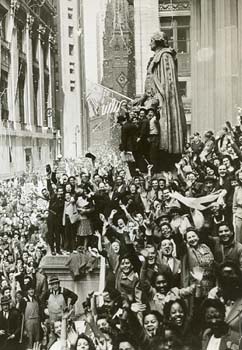 Hitler had squandered most of his offensive power-600,000 men-in a thrust launched on December 16, 1944, in the Ardennes Forest of Belgium and Luxembourg. Designed to separate Field Marshal Bernard Law Montgomery’s 21st Army Group (the Canadian 1st, British 2nd, and US Ninth armies) from Lieutenant General Omar Bradley’s 12th Army Group (the US First and Third armies), the offensive was only a short-lived success for Germany. When the surprised British and Americans recovered from the shock, they turned the bulge Hitler had created in their lines into just another salient, one filled with Germans to be trapped and destroyed. The battle known popularly as the Battle of the Bulge ended on January 16, 1945, with the linkup of US Lieutenant General Courtney Hodges’s First and US Lieutenant General George Patton’s Third armies.
Hitler had squandered most of his offensive power-600,000 men-in a thrust launched on December 16, 1944, in the Ardennes Forest of Belgium and Luxembourg. Designed to separate Field Marshal Bernard Law Montgomery’s 21st Army Group (the Canadian 1st, British 2nd, and US Ninth armies) from Lieutenant General Omar Bradley’s 12th Army Group (the US First and Third armies), the offensive was only a short-lived success for Germany. When the surprised British and Americans recovered from the shock, they turned the bulge Hitler had created in their lines into just another salient, one filled with Germans to be trapped and destroyed. The battle known popularly as the Battle of the Bulge ended on January 16, 1945, with the linkup of US Lieutenant General Courtney Hodges’s First and US Lieutenant General George Patton’s Third armies.
In January and February, the Allies steadily moved up to the west shore of the Rhine. Some of the hardest fighting of the war on the Western Front raged as the Americans tackled the remaining bastions of the West Wall, the network of German fortifications also known as the Siegfried Line. Patton and his Third Army launched a blitzkrieg against dug-in Germans immobilized by Hitler’s insistence that they stay and fight where they were.
Perhaps the most brilliant moments of the Third Army’s campaigns in Europe occurred in taking the Saar-Palatinate region along the Rhineland. Working in close cooperation with Lieutenant General Alexander Patch’s Seventh Army, the Third surrounded a major segment of the West Wall. By itself, the Third cut off and captured the better part of the German 7th Army. Then the Third and Seventh together cut off and captured the German 1st Army, defending the Siegfried Line. Some 113,000 Germans were killed, wounded, or captured at a cost of 5,220 Third Army and 22,000 Seventh Army casualties. Patton and Patch had more than avenged the Battle of the Bulge by inflicting 80 percent losses on the elite German units they opposed en route to the Rhine. Hodges’s First Army had faced no less difficult opposition, but by the beginning of March, it had fought its way to Cologne. There, on the west bank of the Rhine, it stood poised to make the leap across the river and into Germany.
The Germans had orders to hold off on demolishing the Rhine bridges until the last minute, because they were escape outlets for units that would otherwise be cut off west of the river and forced to surrender. Among the more critically important spans was a 1916 railroad bridge at the village of Remagen named after Field Marshall Erich von Ludendorff, a German WWI hero. The Ludendorff Bridge had been planked over to accommodate vehicle and foot traffic, and in the first week of March 1945, that traffic was headed east-Germans escaping the clutches of Hodges’s First Army.
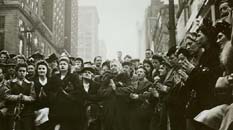 The 27th Infantry Battalion of the 9th Armored Division, on its way to link up with Patton’s Third Army, reached the heights west of Remagen on March 7 and found the Ludendorff Bridge still standing. Brigadier General William Hoge, commanding Combat Command B, sent the 27th Infantry and the 14th Tank Battalion to see whether they could grab the bridge. Just before the Americans set foot on it, a German engineer on the opposite bank twisted the key on a detonator. Nothing happened. American artillery apparently had severed the demolition wire. A German sergeant ran onto the bridge into a spray of American machine-gun fire, in hopes of igniting the secondary charge. His efforts came to naught, but by the time he got back to the east side of the span there was, at last, an explosion.
The 27th Infantry Battalion of the 9th Armored Division, on its way to link up with Patton’s Third Army, reached the heights west of Remagen on March 7 and found the Ludendorff Bridge still standing. Brigadier General William Hoge, commanding Combat Command B, sent the 27th Infantry and the 14th Tank Battalion to see whether they could grab the bridge. Just before the Americans set foot on it, a German engineer on the opposite bank twisted the key on a detonator. Nothing happened. American artillery apparently had severed the demolition wire. A German sergeant ran onto the bridge into a spray of American machine-gun fire, in hopes of igniting the secondary charge. His efforts came to naught, but by the time he got back to the east side of the span there was, at last, an explosion.
Soldiers on both sides of the river watched the bridge rise off its supports with dust and timbers flying in the air. Smoke enveloped the scene. But as it cleared, they saw that the bridge, miraculously, was still standing. The major damage was a 30-foot-wide hole in the planking of the bridge’s approach. US troops filled the hole with dirt, and men started across. It was about 4:00 in the afternoon.
Lieutenant Karl Timmerman led the assault across the bridge, with Lieutenant Hugh Mott and Sergeants Eugene Dorland and John Reynolds clambering below and clearing away German demolition wire. Timmerman and his men secured a foothold at the east end, and troops and new Pershing tanks poured onto the bridge and over the Rhine. By nightfall there was a sturdy bridgehead established on the river’s far shore.
Hoge, who had disobeyed orders to link up with Patton further south, had won a glorious prize for the First Army. Hodges called 12th Army Group commander Omar Bradley with the good news. Bradley recalled the conversation:
“Brad, we’ve gotten a bridge,” announced Hodges.
“A bridge?” replied Bradley. “You mean you’ve gotten one intact on the Rhine?”
“Leonard [Hoge] nabbed the one at Remagen before they blew it up.”
“Hot dog, Courtney. This will bust him wide open! Are you getting the stuff across?”
“I’m going to give it everything I’ve got,” Hodges replied, adding that he would send the 9th and 78th Infantry divisions at once and have the engineers put up treadway and pontoon spans to supplement the rickety Ludendorff Bridge. The 51st and 291st Engineer battalions accomplished this task with great gallantry under enemy fire. When Hodges asked Bradley for permission to send the 99th Infantry Division across, Bradley agreed at once, cautioning Hodges to button up the bridgehead tight. The Germans could be counted upon to respond.
News of the American bridgehead over the Rhine sent Hitler into a frothing rage. At this point, the war was no longer about the welfare of Germany. Hitler was fighting for no other reason than to forestall his own personal destruction. The capture of the bridge at Remagen brought that day of reckoning much closer. The wrathful Hitler ordered a flying court-martial that sentenced to death five officers involved in defending the bridge. (Four of them were actually executed, but Americans captured the fifth in the nick of time.)
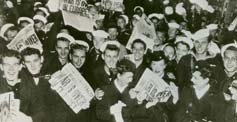 Hitler ordered the bridge bombarded with V-2 ballistic missiles. Eleven landed in the vicinity, but none scored a hit. Hitler sent in the Luftwaffe to bomb the span, but these missions, too, failed to destroy the bridge. German special forces wizard Colonel Otto Skorzeny’s frogmen were deployed, but powerful searchlights picked them out and they were killed or captured before they could harm either the rail bridge or the temporary spans. German artillery pummeled the area. Still, the bridgehead expanded and the bridge stood. Only after 10 days did the bridge collapse, damaged by the initial demolition attempt and the jarring of innumerable near misses of bombs and missiles. By March 21, the Remagen bridgehead extended about 25 miles from the Sieg River on its left (the northern flank) to the southeast, intercepting the Bonn-Frankfurt autobahn.
Hitler ordered the bridge bombarded with V-2 ballistic missiles. Eleven landed in the vicinity, but none scored a hit. Hitler sent in the Luftwaffe to bomb the span, but these missions, too, failed to destroy the bridge. German special forces wizard Colonel Otto Skorzeny’s frogmen were deployed, but powerful searchlights picked them out and they were killed or captured before they could harm either the rail bridge or the temporary spans. German artillery pummeled the area. Still, the bridgehead expanded and the bridge stood. Only after 10 days did the bridge collapse, damaged by the initial demolition attempt and the jarring of innumerable near misses of bombs and missiles. By March 21, the Remagen bridgehead extended about 25 miles from the Sieg River on its left (the northern flank) to the southeast, intercepting the Bonn-Frankfurt autobahn.
The bridgehead disaster meant heads had to roll in the Third Reich. At the top, Field Marshal Gerd von Rundstedt was out as chief of German forces in the west, replaced by Albert Kesselring, the Luftwaffe field marshal who had so ably defended Italy against the Allies’ slow but steady advance.
Kesselring arrayed three German army groups against the Allies along the Rhine. Group H in the north, including the 25th Army and 1st Parachute Army, would oppose the grand offensive across the Rhine planned by Montgomery’s 21st Army Group. In the southern sector of the front, Kesselring had Army Group Gunder Colonel General Paul Hausser to pit against Lieutenant General Jacob L. Devers’s 6th Army Group, which included the US Seventh and French 1st armies. At the center of the front, German Army Group B, which included the 15th Infantry and 5th Panzer armies under Field Marshal Walther Model, would confront Bradley’s 12th Army Group. Model’s Ruhr-region army group of more than 325,000 men was the prime target of the coming Allied campaign.
The Allied offensive was set to begin on March 24th with the 21st Army Group crossing the Rhine at Wesel, but Patton stole the show from the British with a boat assault across the Rhine two nights earlier. Colonel Paul J. Black’s 11th Infantry Regiment made the initial crossing. By the afternoon of the following day, the entire 5th Infantry Division was across. Referring to Montgomery’s meticulously prepared offensive, Patton’s headquarters reported to Bradley the following day, “Without benefit of aerial bombing, ground smoke, artillery preparation, and airborne assistance, the Third Army at 2200 hours, Thursday evening, March 22, crossed the Rhine River.”
Patton himself had gone over on a treadway bridge, pausing midway across the river to pay a biological tribute to the enemy’s great barrier by urinating in the Rhine. On the opposite bank, he stumbled and fell in the dirt in studied imitation of William the Conqueror’s fall on a British beach in 1066. Like William’s fall, Patton’s was an embrace of enemy soil as his own.
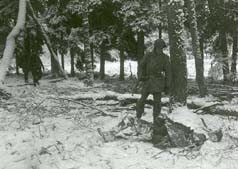 Meanwhile, Lieutenant General William Simpson’s US Ninth Army and Hodges’s First army were, respectively, the northern and southern limbs of a giant pincers that would envelop the Ruhr valley-the core of German industry and coalmining, stretching from the Rhine east about a third of the way to the Elbe River-and Model’s Army Group B. By the 28th, it had already become clear to any German reading a map that the Allies were trapping Model in a vise. That same day, General Dwight D. Eisenhower, the supreme Allied commander in Europe, was firming up a grand strategic plan. In a dispatch to Marshal Joseph Stalin of the Soviet Union, Eisenhower made it clear that the British and Americans were not going to compete with the Russians in a race to capture Berlin. The main thrust of the American advance would be toward Leipzig, 50 miles southwest of the capital. The northern shoulder of the American front would come to rest on the Elbe.
Meanwhile, Lieutenant General William Simpson’s US Ninth Army and Hodges’s First army were, respectively, the northern and southern limbs of a giant pincers that would envelop the Ruhr valley-the core of German industry and coalmining, stretching from the Rhine east about a third of the way to the Elbe River-and Model’s Army Group B. By the 28th, it had already become clear to any German reading a map that the Allies were trapping Model in a vise. That same day, General Dwight D. Eisenhower, the supreme Allied commander in Europe, was firming up a grand strategic plan. In a dispatch to Marshal Joseph Stalin of the Soviet Union, Eisenhower made it clear that the British and Americans were not going to compete with the Russians in a race to capture Berlin. The main thrust of the American advance would be toward Leipzig, 50 miles southwest of the capital. The northern shoulder of the American front would come to rest on the Elbe.
German propaganda had affected the thinking at Eisenhower’s Supreme Headquarters of the Allied Expeditionary Force (SHAEF). The Germans were warning that they intended to make a long-term last stand in a “national redoubt” in the mountains of southern Bavaria and northern Austria. To close out that possibility, Eisenhower planned to swing the Third and Seventh armies to the right, southward, as they crossed Germany. His decision was based on a determination that a guerilla war in the Bavarian Alps could tie down his troops for months, while capturing Berlin had little military worth beyond propaganda value.
Eisenhower’s decision remains controversial to this day. Though conceding Berlin to the Soviets pleased Stalin, a rift was inevitable. Stalin never dealt in good faith with his allies and would have precipitated a Cold War between the East and West anyway.
The war between the Allies and Germany was still hot on March 28 and through April 4, as the Americans made rapid progress surrounding Model’s Army Group B and penetrating into the German heartland. The German west was crumbling, losing cohesion as a front. Despite counterattacks from Army Group B, the two US armies completed their encirclement of the Ruhr Pocket-as the portion of the valley where Model’s forces were concentrated came to be called-on March 31. Hitler’s orders to Model were to defend the Ruhr as a gigantic fortress. But Model’s men had only two to three weeks’ worth of rations left.
As Army Group B withered, American forces found their advance into Germany to be relatively easy compared to the nightmarish battles on the west bank of the Rhine. The autobahn superhighways, built by Hitler for rapid cross-country movement of troops (an inspiration for President Eisenhower’s Interstate Highway program of the 1950s) proved to be more than adequate to the task-at least for the Americans. US troops motored across the country at a pace of 50 to 100 miles a day on the state-of-the art highways-frequently with German POWs jamming the grassy median between the eastbound and westbound lanes as they marched to holding cages far to the rear. The US Third Army was making significant progress of its own, advancing as deep into Germany as Gotha and Mulhousen, in the country’s heartland. Patch’s Seventh Army was beyond the river and had reached Würzburg by April 4.
Hitler responded with the creation of the 12th Army, largely a redrawing on paper, built from scattered units in northeast Germany, with General Walther Wenck in command. Hitler ordered Wenck to cut through nearly 200 miles of American-held territory, link up with Army Group B, and then drive all the way to the Rhine. The jumping-off points for the attack were places on the east bank of the Elbe River already in the hands of the US Ninth Army when Hitler wrote the orders. The plan was pure fantasy.
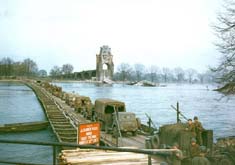 After the Ninth and First armies cut the Ruhr Pocket in half, Hitler simply ordered the two halves to reunite. Instead, the Americans overran the eastern half almost as soon as Hitler issued the order. On April 18, with food and ammunition almost completely gone in the pocket, Model signed an order dissolving Army Group B. For honor’s sake, it wasn’t a capitulation. Instead, it was a decree that, in effect, every man was on his own. Thus the largest organized body of German troops on the Western Front was dissolved. Model later committed suicide.
After the Ninth and First armies cut the Ruhr Pocket in half, Hitler simply ordered the two halves to reunite. Instead, the Americans overran the eastern half almost as soon as Hitler issued the order. On April 18, with food and ammunition almost completely gone in the pocket, Model signed an order dissolving Army Group B. For honor’s sake, it wasn’t a capitulation. Instead, it was a decree that, in effect, every man was on his own. Thus the largest organized body of German troops on the Western Front was dissolved. Model later committed suicide.
Kesselring had nothing even remotely resembling an organized line that might resist the Allies in the west. Most of what Germany could muster was being thrown against the Russians. There was an unspoken agreement among German army commanders that the war was lost and it was better that the British and Americans grab as much territory as possible, rather than the Russians. Civilians being captured by the Soviets were bearing the brunt of revenge for years of atrocities committed during the German invasion of the Soviet Union. German females of all ages faced the probability–nearly a certainty–of rape. Murder and looting were everywhere in the expanding Soviet zone of conquest. It was little wonder that the German army was willing to stand and die fighting the Russians while the Americans and British gained more and more ground.
This thinking did not penetrate as far as the Hitler Youth or into the thick skulls of the Waffen 55 units. As U5 troops advanced, some villages and towns greeted them with open arms, and the Americans behaved properly, leaving people and property mostly unmolested. Where there was resistance, the Americans used artillery and tactical air strikes to level the offending town. A complicating factor for the German civilians was that fanatic Hitler Youth detachments were making last stands against the wishes of the townspeople they purported to defend. In one incident, the locals convinced a Hitler Youth detachment to abandon its proposed defense. One of the boys contacted an SS unit, which then rolled into town and hanged the mayor for dissuading the youths from fighting.
Regular army units were subjected to similar summary justice at the hands of the 55. All over both German fronts, soldiers who had tried to surrender or who had simply been in the wrong place at the wrong time dangled dead from lampposts with placards labeling them as traitors or cowards. Right after the loss of the bridge at Remagen, Hitler declared that any unwounded soldier who surrendered would be punished with attacks on his family. That harsh decree and the summary hangings and shootings by the 55 ensured that some semblance of resistance would continue to meet the advancing Americans.
As the American armies penetrated into Germany, a curious change of attitude toward the German people took place. American soldiers reported that they hadn’t liked the French civilians as much as they liked the Germans, at least when they first began to meet them. German villages, so neat and tidy, reminded them more of home than French towns had, and the German people themselves seemed hard-working, clean, and much more like Americans. The soldiers noticed that unlike the French, German civilians typically began to clean up and repair war damage while the front-line troops were still rolling through town.
And then the soldiers discovered the concentration camps. They found Buchenwald in Weimar, and others, large and small; Germany was studded with them. When Patton’s army came upon the Ohrdruf Nord camp near Gotha, Eisenhower arrived to confirm the unbelievable reports firsthand, inspecting the camp with Bradley and Patton. While Bradley stood mutely revolted at the sight of piles of emaciated corpses covered in lice, Patton vomited in disgust. Eisenhower ordered every unit not in the battle line to be brought to see the horrors of the camps scattered about Germany. He cabled Washington and London to urge that government representatives and reporters be brought in as witnesses to document the Nazi atrocities.
Everywhere the advancing Allies went, the horrors multiplied. Word spread through the ranks that what their governments and officers had said all along about the Nazis was not propaganda. If anything, the reports had been mild. War is often a senseless horror to the men whose duty it is to fight, but as veteran and author Paul Fussell notes, it dawned on the men that the crusade in Europe had been a battle for civilization and the very dignity of human life. The Allies were on the right side.
Besides the horrors of Ohrdruf Nord, Patton’s men also uncovered the greatest treasure trove captured by a conquering army in modern times. About 60 miles west of Buchenwald, Americans found a German gold reserve in the Merkers salt mine. There were three billion paper Reichsmarks in bales (no more payroll for German servicemen). There was another $200 million in gold bullion, a repository of gold teeth taken from deceased prisoners of the Reich, sacks of gold coins, and works of art from the KaiserFriedrich Museum. Patton joked that the gold could be used either to strike medals for all the soldiers of the Third Army or to finance new weapons and equipment when Congress slashed the defense budget after the war.
Famous German cities were falling every day as April waned. Nuremburg, the spiritual home of the Nazi party and the site of its annual rallies, fell on the 19th, as did Leipzig. Munich was occupied on the 30th. The Seventh Army swung south in the direction of Austria and Hitler’s personal retreat in Berchtesgaden. Patton headed east for Czechoslovakia. At Torgau, on the Elbe River, the US First Army linked up with the Soviets on April 25, and the Reich was cut in half. That same day, the United States concluded its strategic bombing of Germany. The Third Army had crossed the border into Czechoslovakia when it was ordered to stop at Pilsen.
Hitler would not be returning to his beloved mountain retreat, the Berghof, at Berchtesgaden. He was trapped in a surrounded Berlin. The US First Army, which had sent patrols into the city’s western suburbs, stayed put as ordered, and the Soviets fought one last monumental battle for possession of the city. On April 30, Hitler and his mistress, Eva Braun, whom he had married the previous day, committed suicide in the bunker of the Reichs Chancellery and the government passed over to the control of Grand Admiral Karl Dönitz.
The German government tried to surrender to the Western Allies only. On May 6 Colonel General Alfred Jodi was flown to SHAEF headquarters in Rheims, France, to negotiate a surrender. Eisenhower refused to negotiate a separate capitulation to the West, and he refused to deal with Jodi in person. To Eisenhower, Jodi was not really a soldier, and the German military was not worthy of the respect given to real soldiers, sailors, and airmen. He believed it was part of a gangster regime that stained the honor of soldiers. With little negotiating leverage, Jodi accepted Eisenhower’s terms on May 7. Officially, at midnight as May 8 began, Germany surrendered to the Western Allies and Russians alike. At the insistence of the Russians, however, a second surrender ceremony took place in Berlin later on the 8th.
Though London erupted in a two-day celebration, festivities in the United States were muted. Crowds gathered in New York, to be sure, but President Harry Truman’s radio announcement, made with the wish that President Franklin D. Roosevelt (who had died on April 12) could have lived to see the victory, was bittersweet. Americans looked apprehensively toward the Pacific and the appalling losses at Iwo Jima and Okinawa. Japan was fighting to the last man, resorting even to suicide as a weapon. Though deeply grateful that the European war was over, Americans steeled themselves for the horrors to come on the Japanese islands.
View more photos here, from our gallery “America Beats the Nazis“.
Copyright 310 Publishing, LLC. All rights reserved.



FOLLOW US »
